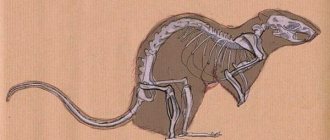Risk factors
Hamster breed
Any rodent can experience severe diarrhea, but some breeds are not susceptible to ileitis. For example, dwarf hamsters.
Among patients with “wet tail”, Syrian rodents with long hair are often found. When choosing a hamster breed, study its characteristics, including propensity and ileitis. It would be a good idea to consult with the breeder and veterinarian.
Extra attention
Desulfovibrio is a bacterium that often affects young hamsters under 8 weeks of age. Weak immunity is not able to resist the pathogen. It is worth paying attention to the health of a small animal before buying it from a nursery.
Handling is dangerous
Severe stress can trigger the appearance of a “wet tail.” This often affects young rodents that are taken from their mother before the age of two months. Strengthening the immune system of a young hamster occurs within a week in a new family.
Important! When buying a small animal, do not rush to handle it often. The hamster will need time to adapt.
Gastrointestinal diseases
Ileitis in hamsters occurs as a result of E. coli entering the body. Common reasons:
- poor quality food;
- non-compliance with terms and conditions of its storage;
- irregular replacement of water in the drinking bowl;
- wet and untreated litter.
Such conditions provide a favorable environment for the development of bacteria.
Wet tail is a consequence, not a cause
At best, severe diarrhea may be due to a less serious illness. However, ileitis is difficult to treat even under the supervision of a veterinarian.
The first symptoms should be a signal to contact a veterinary hospital. It will take a lot of time and effort to save a pet.
Anatomy of the Djungarian hamster
The Djungarian hamster can be distinguished from the Syrian by the presence of hair on the limbs, by the color of the hair, and by the gray stripe that runs from the head to the tail. The Dzungarian hamster grows up to 10 cm in length, and the Syrian hamster up to 20 cm. The Dzungarian hamster bears the fetus in 19–22 days, and the Syrian hamster in 16 days. In the female, the uterus is divided into 2 parts.
Hamsters have identical ears. They perform the functions of hearing, coordination and maintaining balance.
Symptoms of the disease and methods of diagnosing it
The main danger of the disease is that the latent period can last several weeks, so you can buy an already sick animal whose disease is in the incubation period. Hamsters aged 3-8 weeks are most vulnerable to the disease.
“Wet tail” is the name used among the people. In professional language, bacterial
the infection will be called proliferative ileitis, since, first of all, the ileum suffers from it. The animal begins to have diarrhea: first it is watery discharge, and then bloody discharge, which has a characteristic foul odor. The back of the hamster is wet, which is why the disease has earned its popular name. Often the animal experiences rectal prolapse, because the intestines constantly suffer from spasms. Diarrhea leads to dehydration, and in this condition the rodent can live no longer than three days. The disease can be diagnosed only by clinical symptoms.
The incubation period can last 10 days. There are clinical signs of “wet tail” in hamsters:
- severe diarrhea with a strong odor;
- blood appears in diarrhea;
- the animal sits hunched over;
- the fur is tousled, the shine of the coat has disappeared;
- restless and aggressive behavior.
Due to abundant liquid secretions, the back of the body becomes wet. The animal is severely dehydrated. Loss of appetite leads to sudden weight loss.
Symptoms of proliferative ileitis:
- Prolonged lack of appetite;
- Weakness, apathy, drowsiness;
- Change of behavior to aggressive and cruel;
- Wet back of body due to constant diarrhea.
Isolate your sick hamster
Ileitis is a contagious infectious disease. To prevent other pets from catching the disease from a sick hamster, it is better to house the rodents during treatment.
Important! The infection spreads not only due to direct contact between hamsters. A healthy animal can become infected from a sick animal through the owner’s hands, toys and other objects.
The right decision would be to temporarily transfer custody of healthy rodents to a family friend. This measure will help prevent the spread of the disease.
Restore your pet's water balance
Severe diarrhea causes the hamster to lose moisture from its body. The animal refuses to consume food and liquid.
Check the degree of dehydration as follows. The owner needs to carefully feel the withers behind the ears of the small animal with his fingers. If the fold straightens out immediately, then the fluid content in the body is considered acceptable. In a sick hamster, the skin fold very slowly returns to its previous shape.
Injections are the fastest and most effective method of combating dehydration. The owner can independently inject under the skin, but intra-abdominal administration of drugs is performed only by the hand of a veterinarian. The following drugs are used:
- ringer's lactate;
- 9% saline;
- 5% glucose solution.
The dose is prescribed by the veterinarian according to the weight of the sick hamster.
Treat your pet at home
When the first symptoms of a “wet tail” appear, the responsible owner is faced with the task of reducing diarrhea. Cereal decoctions are suitable for this.
Important! Cereal decoction and other folk methods only temporarily relieve the rodent from severe pain and diarrhea. Self-medication at home does not lead to recovery. The entire incubation period must be supervised by a veterinarian.
Keep your hamster warm
Small mammals are characterized by a high ratio of the body surface to its mass. Therefore, sick hamsters are prone to severe hypothermia. This condition poses a danger to a weak body.
The optimal temperature for a hamster in a room is 21-26 0C. The owner should prevent the appearance of drafts in the place where the cage with the sick animal is located. The litter must be clean and dry.
Reduce stress
While the animal is under the care of a veterinarian, its owner can contribute to a speedy recovery. To do this, you need to eliminate possible stressful situations in this way:
- do not move the rodent unnecessarily (only to the veterinary hospital);
- even an isolated animal should have a secluded place to rest;
- the hamster must sleep at any time of the day, for this reason family members try not to make noise near the cage;
- A recovering pet will want to climb and dig again; you should not deprive him of this opportunity.
To restore strength, the hamster will need time, silence and a calm environment.
Hygiene
The disease will progress if:
- do not change the litter;
- do not monitor ventilation and humidity in the room with the cage;
- keep your diet the same.
Disinfection of the cage is a mandatory measure when identifying ileitis in a hamster, because the infection spreads through secretions.
If a sick hamster dies and a cage remains behind, then you need to replace all possible parts of it:
- drinking bowl;
- feeder;
- sunbeds;
- ladders and other equipment.
What remains is treated with a disinfectant solution. Any detergent that contains chlorine will do. Then the cage is rinsed generously with water and ventilated. Such measures will preserve the life and health of the new pet.
Be prepared to make a difficult decision
“Wet tail” in most cases cannot be treated. Animals that survive the disease acquire immunity, but complications with the digestive system are possible.
If treatment started on time does not improve the pet’s condition, then you need to be ready to let him go. It is important that the animal is given a chance.
Eliminate fruits and vegetables from your pet's diet.
Changing your diet can feel like new stress for your hamster. The incubation period requires avoiding vegetables, fruits and other watery foods that will contribute to diarrhea. Dry food will ease the animal's condition. A diet of grains (wheat, oats and wheat) will strengthen the stool. When using ready-made mixtures, you need to make sure that they do not contain any suspicious additives.
Other problems that lead to wet tail
There are many factors that cause the fur around a rodent's anus to become wet. The main ones.
Poor nutrition
Hamsters' favorite treats are fruits and greens. They will rarely refuse an extra piece of apple, pear or banana.
But their excess in the diet will lead to diarrhea. Therefore, fruits should become a delicacy for rodents as a reward.
Poor hygiene
Lack of proper care undermines the pet's gastrointestinal tract and weakens its immunity. The hamster is constantly in contact with dirty and wet sawdust, drinking bowls and food bowls, and a place to rest.
If the cage is not cleaned for a long time, a large amount of dried food and feces accumulates at its bottom.
Gastrointestinal problems
Wet tail appears in hamsters even without bacterial infection. This occurs due to an imbalance of intestinal microflora, when one type of microorganism predominates over another. Once the balance between them is restored, the pet’s health will improve.
Methods of treating the disease
IMPORTANT! We advise you to consult a veterinarian rather than follow advice from the Internet. Always remember that such articles may not be written by DOCTORS.
Eliminating the pathogen
Wet tail is an intracellular bacterium, so you need to resort to an antibiotic that can penetrate the cell and destroy the pathogen. Medicine for hamsters must be selected carefully so that the drug does not have a toxic effect (many antibiotics that are suitable for treating rodents cannot be used on hamsters).
Human medications can be used for treatment - oral suspensions. You can take Biseptol, which combines two active ingredients.
Also, most often, therapy is carried out using Baytril 2.5% (administer 0.4 ml over the skin of the animal per 1 kg of live weight). For a small rodent weighing 250 g, 0.1 ml is enough. Usually the antibiotic is injected once a day for a couple of weeks, and in difficult cases - twice a day.
Dehydration
The cause of death is dehydration, which occurs quite quickly with profuse diarrhea. Trying to give the hamster water is useless, since the liquid will not stay in the cells after passing through the digestive tract. The bad news is that rodents are too small, so intravenous injections are contraindicated for them. The best option for hamsters is intraperitoneal and subcutaneous injections. The owner can inject himself under the skin, but only a professional should inject into the stomach.
For injections, Ringer's Lactate is used, but you can use regular saline as an alternative: for 1 kg of live weight you need to take 40 ml of liquid. At the same time, you will need to inject glucose: 5% of the drug is injected into the body 2-3 times a day. To strengthen the immune system, vitamin C and Catozal are used together with the above drugs.
Treatment should be carried out in a well-washed cage, and hygiene procedures should be constant. When the rodent has completely lost its appetite, you can feed it manually: it is fed with baby formula (without milk protein) from a pipette or insulin syringe. Any succulent food should be excluded from the diet, but care must be taken to ensure that there is no significant loss of water.
Conditions of detention before recovery
The cage needs to be washed every day and the bedding changed to provide a warm and dry environment for the pet and to prevent re-infection of the animal. Juicy food must be completely excluded from the diet.
Proliferative ileitis is a difficult disease that cannot often be cured, even if proper and timely therapy is provided. If treatment attempts are completely excluded, then in 90-100% of cases the rodent dies. Owners can be quite principled when it comes to treating their pets. They exclude antibiotics because of the great harm they cause to the liver, and they consider injections to be a great stress that can kill the hamster. But the real danger comes from the disease, and antibiotics and injections are the only chance for salvation.
Varieties
According to the latest information, there are 19 species of hamsters in the world, which belong to 7 genera. Let's consider information about those species that are suitable for keeping in an apartment.
Djungarian hamster
This is a dwarf hairy-footed species. Such hamsters are often kept at home, as they are clean and non-aggressive towards people. Their body length rarely exceeds 10 cm.
Dzungariki weigh 30-60 grams. This species lives in dry steppe regions and semi-deserts in western Siberia, parts of China and Kazakhstan. The natural color of the rodent is gray-brown. There is a dark stripe on the back that runs along the spine, and a dark spot on the crown.
Syrian hamster
The rodent lives in Syria and Turkey. The hamster grows to a size of about 13 cm, weighs approximately 125 g. The length of the tail is 1.5 cm.
This is a peaceful and sociable animal with a golden coat.
Campbell's hamster
This rodent has an external resemblance to the dzhungarik, but some characteristics differ. Body dimensions are from 7.5 to 10 cm, the weight of the hamster does not exceed 60 g, the tail length is up to 1.4 cm. The paws are shaggy.
The natural color of the rodent is gray-brown. The fur on the belly is gray at the base and white at the tips. There is a thin dark stripe on the back that starts from the neck and ends at the base of the tail.
Roborovsky's hamster
This is one of the smallest representatives of the family. Its weight is 30 g, and its body length is no more than 5 cm. The color of the rodent on the back and head is sandy, the fur on the belly is white. The fur above the eyes is bleached. This hamster is not often found at home.
This is one of the few rodents that gets along well in a group.
Other types of hamsters:
- common hamster;
- Transcaucasian;
- Newton's hamster;
- Mongolian;
- Eversman's hamster;
- Kansky;
- short-tailed;
- rat-like;
- Tibetan;
- long-tailed;
- hamster Radde et al.
Attention! The largest representative of the family lives in the forest-steppes of Europe. This is an ordinary hamster that weighs from 400 to 700 g. Its body grows up to 34 cm in length.
Traditional methods of treatment
Traditional methods can be quite effective in treating human diseases, but with animals the situation is different. Not all recipes that help people are suitable for animals, so you need to be very careful. If you are sick, it is better to consult a veterinarian, but if this is not possible, then you can try using a decoction of grain crops (barley and oats are most often used). This remedy will help stop the diarrhea, and then there should be enough time to take the patient to a veterinary clinic. Traditional methods are aimed at eliminating symptoms and gaining time, and not at fighting the cause.
Other causes of cannibalism
Sometimes it happens that young mother hamsters eat the first litter. This does not happen because they are considered bad mothers. It’s just that the young individual does not fully understand what happened to her, and eats the hamchat as a nuisance. With the next offspring she will be loyal.
Some believe that the female eats babies that do not match her color. For example, if the mother is black, and the hamsters were born black and white or white, then she will certainly eat them. It's all a myth! The color of the cubs has nothing to do with it. A Khomchikha can regulate the number of her offspring, taking into account her maternal capabilities.
Prevention
To prevent the disease from having to be treated, the owner should think about preventive measures. Simple prevention will help you avoid the disease.
There are several rules that all hamster owners need to know:
- buy animals only from official nurseries and require documents confirming that the rodents are healthy;
- choose food after talking with a veterinarian, check the composition of the diet in accordance with the doctor’s recommendations;
- Do not give your hamster food supplements unless necessary;
- “human” food is strictly prohibited (for example, sausages, cheese, sausage, crackers with spices);
- clean the cage daily, wash all objects the pet comes into contact with with antiseptic agents every 14 days;
- do not handle the animal with dirty hands, adhere to personal hygiene when dealing with a rodent.
Wet tail disease can be easily cured if you pay attention to the symptoms promptly. The owner should note the warning signs and take the animal to a veterinarian. It is not recommended to resort to self-medication, since only a doctor will write recommendations regarding medications and dosage. You also cannot ignore the disease - it can be fatal.
The female eats the young
Any mother protects and takes care of her offspring. This feature is inherent in the genes of all females. But this theory is refuted by the fact of cannibalism, which is possible in female hamsters. Why do hamsters eat their babies?
It is not uncommon for a hamster, being in a cage with her babies, to simply eat them. Some believe the main problem is the lack of liquid food in the cage, others believe it is the lack of water.
Owners should monitor the maintenance of hamsters
According to experts in the field of animal husbandry, it is the lack of fluid that is the main cause of cannibalism in hamsters. This can be explained by the fact that during the lactation period, the hamster, like any other female mammal of the species, has an increased need to drink. The liquid helps the mother's body produce milk. When lactation decreases, hamsters sucking the hamster's papillae cause her unbearable pain. It is a signal to the female that the offspring will not survive due to lack of milk. As a result of this, the animal instinct is triggered, and the mother eats partially or completely the cubs.
You can avoid such consequences. A few days before the babies are born and during the feeding period, the hamster should be given wet food and protein foods (cottage cheese, milk, boiled chicken meat). There should always be clean and fresh water in the drinking bowl. In such conditions, the hamster will be loyal to her babies.











